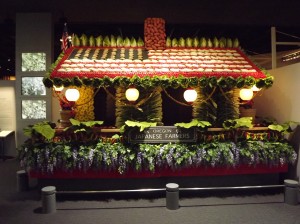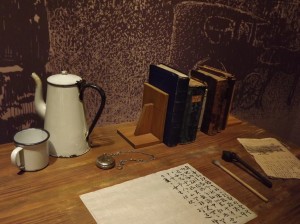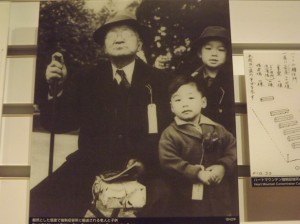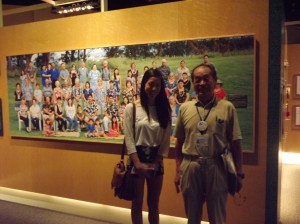A Student’s Version of Yokohama: Museum Tears
By Joseph Mastron
So here’s how the day started. We woke up an hour earlier than usual to catch the early train to Yokohama, some of us just tired, others really tired. So we rush, run, and scramble to Jimbouchou station, hurry to get our tickets, jump on the Hanzomon line, and head off the wrong way. Luckily, the entire day didn’t follow this course.
After correcting our mistake, we arrive in Yokohama, to a dreary, rainy day. Yet, even in the wet misty dampness, Yokohama was BEAUTIFUL. There were towers rising above the rainclouds, a Ferris wheel in glorious and huge splendor, and our morning’s destination: the Japanese Emigration Museum. Here, the lives and lifestyles of those who have left Japan to establish a home overseas are recorded.
Here, at the very entrance, is a replica of a Japanese-American Oregonian Farmers’ float from the early 20th century. After a brief video introducing the museum, luckily in English, as so many things seem to be here in Japan, we were sent off through the museum.
As with every Japanese museum so far, I was struck with the intricate detail that went into preparing models and displays and graphs and charts.
And then I walked, well, rather read, my way through the museum. I read tales of the Japanese workers who were brought to Hawaii to work in sugarcane fields for little money, tales of students who came to California to work during the day in order to study English at night, and even tales of the Japanese people who went to live in South America, especially Brazil.
I was impressed, thoroughly informed. But none of these exhibits struck me as hard as one: the Japanese people, Issei and Nisei (First and second generation), who came to Southern California, people who labored their entire lives to establish families and businesses.
These were people who during the war were treated like criminals, like enemy aliens, in their chosen land and sometimes the land of their birth. I read letters between families in broken elementary English, expressing their love with difficulty, since Japanese language was forbidden, and dangerous to use.
And I thought to myself, “Why?” This is the evil that comes when people draw lines and borders and fictional races, and then hate each other because of it. And I felt guilt, not for California, not for the United States, but for the Human Race. That feature which should bring us together, we all too often forget. After I, yes, I’ll admit it, wiped the tears from my eyes, I continued. As I walked, taking pictures, I caught up to another of our USC students, Amanda. And behold, she was being led around the museum by a darling older gentleman, who was stopping to explain the exhibits as we went. I couldn’t help but tag along to catch a bit of his aged wisdom.
And it made me think. This is forgiveness, an older man, who might have been born during or maybe just after the war, who knew the history, who knew what happened at the internment camps, and was still willing to lead a group of Americans through the museum, smiling, sharing tidbits of his knowledge, and skipping over the guilt-causing parts.
After thanking our elderly angel, I went to wait with the rest of the group, in our customary “relaxation-and-rest-while-the-unnamed-catches-up” time. After a few minutes, we were able to head out again, off to visit Yokohama Chinatown.








